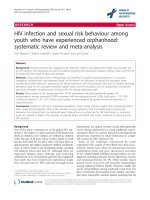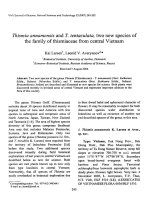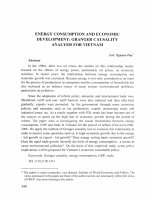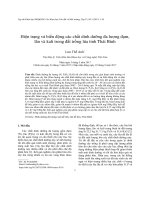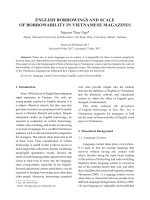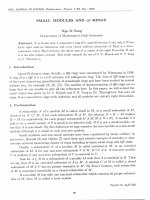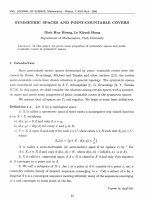DSpace at VNU: Homosexuality-Related Stigma and Sexual Risk Behaviors Among Men Who Have Sex With Men in Hanoi, Vietnam
Bạn đang xem bản rút gọn của tài liệu. Xem và tải ngay bản đầy đủ của tài liệu tại đây (310.29 KB, 8 trang )
Arch Sex Behav
DOI 10.1007/s10508-014-0450-8
ORIGINAL PAPER
Homosexuality-Related Stigma and Sexual Risk Behaviors Among
Men Who Have Sex With Men in Hanoi, Vietnam
Huy Ha • Jan M. H. Risser • Michael W. Ross
Nhung T. Huynh • Huong T. M. Nguyen
•
Received: 2 December 2013 / Revised: 16 November 2014 / Accepted: 24 November 2014
Ó Springer Science+Business Media New York 2015
Abstract This article examined the associations between
three forms of homosexuality-related stigma (enacted, perceived, and internalized homosexual stigmas) with risky sexual
behaviors, and to describe the mechanisms of these associations,
among men who have sex with men (MSM) in Hanoi, Vietnam.
We used respondent-driven sampling (RDS) to recruit 451
MSM into a cross-sectional study conducted from August 2010
to January 2011. Data were adjusted for recruitment patterns due
to the RDS approach; logistic regression and path analyses were
performed. Participants were young and single; most had
attended at least some college. Nine out of ten participants
engaged in sexual behaviors at moderate to high risk levels.
Compared to those who had no enacted homosexual stigma,
men having low and high levels of enacted homosexual stigma,
respectively, were 2.23 times (95 % CI 1.35–3.69) and 2.20
times (95 % CI 1.04–4.76) morelikely to engage in high levels of
sexual risk behaviors. In addition, there was an indirect effect of
perceived homosexual stigma and internalized homosexual
stigma on sexual risk behaviors through depression and drug and
alcohol use. Our study provides valuable information to our
understanding of homosexual stigma in Vietnam, highlighting
H. Ha (&)
The Institute of Population, Health and Development, 18 Alley 132
Hoa Bang Street, Cau Giay District, 10000 Hanoi, Vietnam
e-mail:
J. M. H. Risser Á M. W. Ross
School of Public Health, The University of Texas, Houston, TX, USA
N. T. Huynh
School of Medicine and Pharmacy, Vietnam National UniversityHanoi, Hanoi, Vietnam
H. T. M. Nguyen
Center for Community Health Research and Development, Hanoi,
Vietnam
the need for provision of coping skills against stigma to the gay
community and addressing drinking and drug use among MSM,
to improve the current HIV prevention interventions in
Vietnam.
Keywords Homosexuality-related stigma Á
Sexual risk behavior Á MSM
Introduction
In Vietnam, homosexuality is often viewed as an immoral and
unacceptable lifestyle that conflicts with traditional values that
highlight lineage continuity and men’s responsibilities to their
families and the society. Due to stigma, men may conceal their
sexual orientation, ignore the riskiness of some of their sexual
behavior, fail to seek HIV/sexually transmitted infection (STI)
testing and treatment when needed, and avoid involvement in
HIV prevention activities (Doll & Beeker, 1996; Gill, 2002;
UNAIDS, 2007).
Drawing on stigma theories (Deacon, 2006) and Goffman’s
(1963) work, Earnshaw and Chaudoir (2009) have developed a
practical and comprehensive HIV-related stigma framework
that emphasizes individual-level conceptualizations of stigma.
This framework depicts three stigma mechanisms—enacted,
anticipated, and internalized—to describe how ‘‘social devaluation’’ impacts those who are infected with HIV and those
who display HIV-related risk behaviors such as MSM, commercial sex workers, and injecting drug users. Earnshaw and
Chaudoir indicated that using a framework of multiple-stigma
measures is better than a single-stigma mechanism framework
in assessing how stigma impacts individuals, and that the
multiple-stigma framework is more useful in predicting
important psychological, behavioral, and health outcomes.
123
Arch Sex Behav
The linkage between stigma and increased sexual risk
behaviors among MSM is inconsistent in the literature. Some
studies failed to find an association (Brimlow, Cook, & Seaton,
2003; Courtenay-Quick, Wolitski, Parsons, & Gomez, 2006);
while other studies have demonstrated that stigma and high-risk
sexual behaviors are related (Alvy, McKirnan, Mansergh, &
Koblin, 2011; Koblin, Husnik, Colfax, & Huang, 2006; Preston,
Cain, Schulze, & Starks, 2004; USAID and Horizons Program/
Population Council, 2008). A recent large-scale study conducted
in 38 European countries indicated that higher levels of internalized stigma were associated with unprotected anal intercourse
amongMSM (Ross, Berg, Schmidt, & Hospers,2013). Although
there is some evidence of associations between stigma and
sexual risk behavior, the mechanism ofsuch associations remains
unclear and warrants further research. Preston, D’Augelli,
Kassab, and Starks (2007) found that low levels of internalized
homophobia and certain mental health conditions, such as low
self-esteem, mediated the stigma and sexual risk behavior relationship. Stigma is often cited as an explanation for the increased
mental health outcomes such as depression in MSM (Herek,
Gillis, & Ogan, 2009), and may help describe why gay men have
more depression compared to heterosexual men (Berlan et al.,
2010; King, Semlyen, Tai, Killaspy, & Nazareth, 2008; Marshal,
Friedman, Stall, King, & Morse, 2008; Mimiaga, Noonan, Donnell,Safren,&Mayer,2009).Depressionwithotherpsychosocial
problems such as substance/alcohol abuse and violence may
synergistically interact with one another, resulting in elevated HIV
risk behavior among MSM (Hirshfield, Remien, Humberstone, &
Walavalkar, 2004; Safren, Raisner, Herrick, & Mimiaga, 2010;
Stall, Paul, Greenwood, Pollack, & Catania, 2001). Some studies
indicatethatdepressionandsexualrisktakingarerelated(Bancroft
et al., 2003; Koblin et al., 2006), while others do not (Stall,
Mills, Williamson, Hart, & Catania, 2003). In Vietnam, there
was an interaction between substance and alcohol abuse, and
depression among MSM, especially among male sex workers
(MSW), that was linked to sexual risk taking (Colby, 2010).
Our article aimed to (1) estimate the prevalence of homosexuality-related stigma, (2) examine the relationship between
homosexual stigma and sexual risk behavior among MSM in
Hanoi, Vietnam, and (3) to explore the mechanisms of this
relationship.Ourhypothesiswas that ahighlevel ofstigmawould
havedirect effectsonriskysexual behaviorandindirecteffects on
sexual risk taking through depression. To our current knowledge,
there have been no published studies assessing the effect of
stigma against MSM on sexual risk taking behaviors in Vietnam.
Method
Participants
A cross-sectional design was used to collect data from 451 MSM
in Hanoi from August 2010 to January 2011. Preliminary work
123
in preparation for data collection included identifying networks
of MSM and conducting interviews with 10 MSM to pilot and
refine the survey instrument.
Procedure
Recruitment was done using the respondent-driven sampling
method (RDS), which has been widely used in recent years in
different parts of the world to draw probability samples of hidden populations (Heckathorn, 2002). This method combines a
modified form of snowball sampling, such as chain referral
sampling, with a mathematical system for weighting the data to
compensate for the fact that the sample was not drawn randomly.
With the appropriate weighting, RDS produces unbiased prevalence estimates (Salganik, 2006).
To be eligible for this study, individuals had to be biologically
male; with age over 18 years; be residents of Hanoi for at least
3 months before the survey implementation; report anal sexual
contact (oral and/or anal sexual contact) with other men at least
twice during the previous 90 days; have a valid referral coupon
(related to the RDS process); and be willing and able to provide
informed consent. Initially, ten men who were identified during
thepreparationprocesstohavelargesocialnetworksofgayfriends
were selected as‘‘seeds.’’Each‘‘seed’’received three unique,
non-replicable recruitment coupons to give his peers who
were expected to fit the eligibility criteria. Next, individuals
with valid coupons presented themselves to be interviewed.
Before each interview, a short screening check was performed to ensure eligibility and avoid duplication of subjects,
and informed consent form was signed. The process was
repeated until the desired sample size was reached. There
were between five and seven waves of RDS recruitment for
each ‘‘seed’’ and no RDS waves died out by their own.
Before the interview, the study purpose—to improve the
MSM’s health—was explained and the participant was asked to
voluntarily sign the consent form for his participation in the
study. Face-to face interviews using a structured questionnaire
took place in a private room to ensure the confidentiality and
protection of subjects’ responses. Trained interviewers conducted these interviews at the HIV/STD volunteer counseling
and testing clinic placed in Hanoi Dermatology Hospital. Upon
completion of the interview, each man was given three uniquely
numbered coupons to recruit other eligible acquaintances to
participate in the study. An incentive equivalent of $10 US
dollars (USD) was provided to the participant for agreeing to the
study and US $2.50 was given for each successful peer recruitment. The study was reviewed and approved by the Johns Hopkins University’s Center for Communication Programs and the
University of Texas Health Sciences Center at Houston, and
the internal review board of the Vietnam Institute for Social
Development Studies, which has registered with the NIH
(IRB00006556). The study was implemented by the Center for
Community Health Research and Development in Hanoi. No
Arch Sex Behav
identifying information, such as names or addresses of respondents, was collected in the study.
Measures
Dependent Variables
Sexual risk behaviors were categorized by the degree of vulnerability to HIV infection as (a) no risk, (b) low risk, (c)
moderate risk, and (d) high risk. The classification was developed with reference to Ostrow, DiFranceisco, and Wagstaff
(1998) and Preston et al. (2004) and based on (1) number of
sexual partners within the 30 days prior to the survey, (2) whether one engaged in anal sexual intercourse, and (3) the consistency of condom use during sexual intercourse in the past
30 days. Men were classified as ‘‘no risk’’ if, within the last
30 days, (1) they did not have a sexual partner or (2) they were in
a monogamous relationship, but did not engage in sexual
intercourse. Men were placed in the‘‘low risk’’group ifthey were
in a monogamous relationship, and engaged in sexual intercourse but always used condoms during sexual intercourse. This
group also included men who had multiple sexual partners but
always used condoms during sexual intercourse. The‘‘moderate
risk’’ was assigned to men who were in a monogamous relationship and did not always use a condom during sexual intercourse. Men were put in the‘‘high risk’’group if they had multiple
sexual partners and did not always use a condom during sexual
intercourse. For logistic regression analysis, because the distribution of sexual risk behavior was skewed toward the‘‘high risk’’
group, the other three groups—no risk, low risk, and moderate
risk—were combined, and the final comparison was between
‘‘high risk’’and all other risk categories combined.
Independent and Control Variables
Homosexuality-related stigma was measured in three forms:
enacted homosexual stigma (enacted stigma), perceived homosexual stigma (perceived stigma), and internalized homosexual
stigma (internalized stigma). These forms were adapted from
previous studiesconductedinChina(Liu,Feng,& Rhodes,2009;
Neilands, Steward, & Choi, 2008) and piloted with Vietnamese
MSM in Hanoi (Ha, Ross, Risser, & Nguyen, 2013). The adapted
scales showed good construct validity with a fairly high internal
reliability overall, as well as with each type of stigma.
Enacted stigma measures the actual experience of prejudice
or discrimination directed toward a man due to his homosexual
activities. Eight questions were used to measure enacted stigma,
including one screening question of whether his family, friends,
and others knew about his homosexual behavior, and seven
subsequent questions regarding prior experiences with homosexual discrimination (Ha et al., 2013) with a 4-point Likert scale
responses (1 = never; 2 = once or twice; 3 = a few times; 4 =
many times). Perceived stigma measures a man’s perception of
how he is being stigmatized against in the ‘‘eyes’’ of the ‘‘community’’because of his same-sex practices. This form was measured by asking eleven questions designed to rate the degree of
respondents’ disagreement/agreement (1 = strongly agree; 2 =
agree; 3 = disagree; 4 = strongly disagree) concerning negative
attitudes in the community toward stigmatized persons (Ha et al.,
2013). Internalized stigma measures a man’s negative self-perceptions and beliefs about his same-sex behavior due to feelings
of shame and fears of the society’s negative perceptions of
homosexuals. It was measured using seven questions in which
men were asked to rate their level of disagreement/agreement
(1 = strongly agree; 2 = agree; 3 = disagree; 4 = strongly disagree) in regard to their self-beliefs and feelings such as shame or
disgust, resulting in devaluation and internal conflict (Ha et al.,
2013). Each form of stigma was represented by a summative
score; a higher score indicates a higher level of stigma. An individual with a score of 75th percentile or more was considered
having a high stigma score, except for enacted stigma where three
levels of stigma were defined: no, low, and high—as the enacted
stigma composite score was skewed toward zero. Cronbach’s
alphas of the enacted stigma, perceived stigma, and internalized
stigma scales are 0.82, 0.82, and 0.79, respectively.
Depression status was measured using the Center for Epidemiologic Studies Depression Scale with 20 items (CESD-20)
(Radloff, 1977). Participants were rated on the frequency (from
‘‘most or all of the time’’ to ‘‘rarely or none of the time’’) of
depression signs/symptoms they had experienced in the week
prior to the survey. Depression scores were calculated and a
threshold of 16 for indicating the likely presence of significant
depression (Radloff, 1977). Cronbach’s alpha of the scale
exhibited excellent reliability (a = 0.90).
Alcohol use was measured by the 10-item Alcohol Use
Disorder Identification Test scale (AUDIT-10) developed by
the World Health Organization (2001). The four categories of
low, medium, high, and severe levels of alcohol problems
were generated on the basis of the total AUDIT-10 score: less
than 8, 8–15, 16–19, and 20 or above, respectively (WHO,
2001). The reliability coefficient in this sample was 0.82.
Drug use was a binary variable indicating if men reported
using any of the following illicit substances: marijuana, ecstasy,
methamphetamine, ketamine, cocaine, and heroin within 30 days
prior to the survey.
Knowledge about HIV/AIDS was examined through 25 true/
false questions about the cause of HIV/AIDS, HIV transmission,
and prevention of HIV infection. A summative total score was
calculated.HighversuslowknowledgeofHIV/AIDSwasdefined
using the 50th percentile cut-off of the total score. The reliability
coefficient in this sample was 0.83.
A few sociodemographic characteristics, including the
men’s age and education, were also included as control variables
because there is evidence that they were significantly linked to
high-risk sexual activity (Preston et al., 2004).
123
Arch Sex Behav
Statistical Analysis
We used respondent-driven sampling analysis tool (RDSAT)
program (www.respondentdrivensampling.org) to adjust the
analysis for the relative sizes of the participants’ network, to
estimate the weighted prevalence and 95 % confidence intervals
for the socio-economic characteristics and behavioral characteristics of participants. Median, mean, and standard deviation
(SD) were estimated for continuous variables. The individual
weights associated with the outcome variable (sexual risk
behavior) were generated using RDSAT and then were exported
to the STATA software for logistic regression analyses. Odds
ratios (OR), 95 % confidence intervals (95 % CI), and p values
were used in univariate and multi-variable logistic regressions.
Path analysis using the AMOS 18.0 program was performed
to determine the relationships among variables (homosexual
stigma, depression, drug use, alcohol drinking, and HIV knowledge) and sexual risk behavior. Path analysis is often used to
determine the comparative strength of direct and indirect associations between variables, and employs multiple equations to
estimate the effects of hypothesized linkages of a set of variables
(Lleras, 2005). In this analysis, continuous variables such as total
index scores of three stigma forms, depression, alcohol use, and
HIV knowledge were used. We started with and tested the full
model; a reduced model was retained by deleting all paths with p
value [0.20, however the paths of three forms of homosexual
stigma with sexual risk-taking behaviors were kept regardless of
their levels of p value. The goodness-of-fit of the reduced model
was assessed by a non-significant v2 value, the comparative fit
index (CFI), the root mean square error of approximation
(RMSEA), and Tucker Lewis Index (TLI) (Hu & Bentler, 1999).
Subsequently, a path diagram was constructed to show their
linkages.
Results
A total of 451 men participated in the study. The majority of
the participants were young (87.0 % of participants at age
B22 years; mean age: 22.5 years, SD = 5.3), single (96.8 %;
[95 % CI 94.7–98.5]) and had attended at least some college
(75.5 %; [67.6–82.5 %]). More than three-quarters (76.3 %;
[69.5–81.9 %]) of the sample were born outside Hanoi but
currently lived in Hanoi. Most of the men (82.8 %; [76.8–
88.1]) had low levels of HIV/AIDS knowledge. Nearly a half
of the sample reported having more than two sexual partners
within 30 days before the survey. The majority (67.6 %;
[59.0–75.0]) had a depression score higher than 16, which has
been considered ‘‘significant’’ or ‘‘mild’’ depressive symptomatology (Radloff, 1977). Approximately, two out of five
men (40.7 %; [31.1–51.1] in the study had an AUDIT-10
score equal to or greater than 16, indicating high or severe
levels of alcohol use (WHO, 2001) (Table 1).
123
Most men (79.4 %; [74.2–83.6]) reported that they did not
experience homosexual stigma and discrimination. Among
those who did (21 %), many (17.5 %; [13.7–22.5]) exhibited
high rates of stigma/discrimination experience. For perceived
stigma and internalized stigma, the majority of men reported low
levels of perceived stigma (72.7 %; [66.7–78.1]) and internalized stigma (70.1 %; [64.3–76.1]) (Table 1). Nine out of ten men
in the sample admitted that they engaged in sexual behaviors at a
moderate or high level of risk; more than a half reported sexual
behaviors at the high level of risk (results not shown).
We found that only enacted stigma was associated with the
high level of risky sexual behaviors in both the univariate and
multivariate models (Table 2). Compared to those who reported
no enacted stigma, men reporting low and high levels of enacted
stigma were 2.23 [1.35–3.69] times and 2.20 [1.04–4.76] times
more likely, respectively, to have a higher level of engagement
inriskysexualbehaviors.Therewasastrongrelationshipbetween
high AUDIT-10 scores and risky sexual behavior: men who had
AUDIT-10 scores of 16–19 and[19 in the past 30 days were 2.38
[1.24–4.56] times and 2.47 [1.21–5.05] times, respectively, more
likely to engage in high levels of sexual risk intercourse than those
who had an AUDIT-10 score of \8. Also, men who reported
using marijuana, ecstasy, methamphetamine, ketamine, cocaine,
or heroin within the past 30 days were 1.98 [1.25–3.13] times
more likely to engage in high-risk sexual behaviors than others.
Figure 1 illustrates results of the path analysis. All three forms
of homosexuality-related stigma were significantly correlated.
Similarly to the findings shown in Table 2, Fig. 1 indicates that
among the three stigma forms, enacted stigma was directly and
significantly related to a high level of sexual risk behaviors. In
addition, enacted stigma and internalized stigma were significantly associated with depression, which inturnwassignificantly
associated with drug use and alcohol use; both drug and
alcohol use was related to increased sexual risk behaviors. In
addition, internalized stigma and HIV knowledge were significantly associated; however, HIV knowledge was not significantly linked with other factors such as depression, alcohol use,
drug use, or sexual risk behaviors. The model provided an
excellent fit to thesample data, as indicated by the v2 goodness-offit statistics (v2 square = 4.3; df = 13; p value = 0.99 and goodness-of-fit indices (CFI = 1.00; RMSEA = 0.00; TLI = 1.00).
Discussion
The purpose of this article was to examine the relationship
between homosexuality-related stigma and sexual risk behaviors. We tested the hypothesis that homosexuality-related stigma
had both direct and indirect effects on sexual risk taking through
depression. Our findings partially supported the hypothesis: enactedstigmawasdirectlyandsignificantlyassociatedwithsexualrisk
behavior. This result was consistent with previous studies (Koblin
et al., 2006; Thiede, Valleroy, MacKellar, & Celentano, 2003;
Arch Sex Behav
Table 1 Sociodemographic characteristics of men who have sex with men in Hanoi, Vietnam in 2011 (n = 451)
Background characteristics
Population-based estimatesa % (95 % CIc)
No/low/moderate levels of sexual risk
Crude estimatesb % (n)
High levels of sexual risk
Total sample
Age (Median = 21; M: 22.5; SD = 5.3)
18–20 years
57.4 (45.8–71.1)
42.6 (28.9–54.3)
30.6 (23.8–40.2)
20.8 (94)
10–22 years
52.3 (44.4–61.4)
47.7 (38.6–55.6)
56.4 (46.3–62.4)
52.4 (236)
C23 years
51.2 (39.8–68.3)
48.8 (31.7–60.3)
23.0 (9.0–18.8)
26.8 (121)
Education level
Less than college
45.5 (34.1–57.0)
45.5 (34.1–57.0)
24.5 (17.5–32.4)
32.4 (146)
55.1 (47.9–63.3)
44.9 (36.7–52.1)
75.5 (67.6–82.5)
67.6 (305)
Single, never get married
52.7 (46.3–60.3)
47.3 (39.7–53.8)
96.8 (94.7–98.5)
93.8 (423)
Married/divorced/separated
49.1 (25.7–76.5)
50.9 (23.5–74.3)
3.2 (1.5–5.3)
6.2 (28)
Born in Hanoi
58.0 (47.7–70.3)
42.0 (29.7–52.3)
23.7 (18.5–30.5)
31.7 (143)
Born outside Hanoi
51.4 (43.6–59.3)
48.6 (40.7–56.4)
76.3 (69.5–81.6)
68.3 (308)
Student
96.7 (81.2–62.0)
46.9 (38.0–55.4)
66.5 (57.5–74.5)
57.2 (258)
Non-student
52.0 (43.0–62.2)
48.0 (37.8–57.0)
33.5 (25.5–42.6)
42.8 (193)
Some college and more
Marital status
Place of birth
Occupation
HIV/AIDS Knowledge score (Median = 10; M = 10; SD = 2.7)
Low knowledge
56.6 (47.4–64.0)
43.4 (36.0–52.6)
82.8 (76.8–88.1)
81.6 (368)
High knowledge
49.1 (28.3–66.8)
50.9 (33.2–71.7)
17.2 (11.9–23.2)
18.4 (83)
B1 partner
80.0 (72.0–87.6)
20.0 (12.4–28.1)
54.0 (47.4–60.4)
37.7 (169)
2–4
[4 partners
23.2 (16.1–31.7)
13.8 (5.9–23.4)
76.8 (68.3–83.9)
86.2 (76.6–94.1)
33.9 (28.3–39.7)
12.1 (8.9–15.6)
42.9 (192)
19.4 (87)
Number of male partners
Depression score (CESD-20) (Median = 22; M = 23; SD = 10)
B16
60.5 (44.4–75.3)
39.5 (24.7–55.6)
32.4 (25.0–41.0)
31.9 (144)
[16
67.7 (58.3–76.9)
32.3 (23.1–41.7)
67.6 (59.0–75.0)
68.1 (307)
AUDIT-10 score (Alcohol use) (Median = 14; M = 14.2; SD = 6.4)
\8
61.9 (49.1–78.4)
38.1 (22.0–50.9)
12.4 (8.0–18.2)
16.2 (73)
8–15
60.2 (50.7–69.9)
39.8 (30.3–49.0)
46.9 (39.7–53.5)
41.5 (187)
16–19
42.5 (30.1–55.5)
57.5 (44.5–69.9)
23.1 (18.5–28.3)
23.1 (104)
[19
40.0 (23.9–55.3)
60.0 (44.7–76.1)
17.6 (12.6–22.7)
19.3 (87)
Yes
60.7 (54.1–69.0)
39.3 (31.0–45.9)
33.9 (27.5–40.7)
30.6 (138)
No
35.1 (23.3–48.6)
64.9 (51.4–76.7)
66.1 (59.4–72.5
69.4 (313)
68.3 (308)
Drug use
Enacted homosexual stigma (Median = 0; M = 3.8; SD = 6.1)
No stigma
60.3 (53.3–68.1)
39.7 (31.9–46.7)
79.4 (74.2–83.6)
Low stigma
27.5 (18.0–39.3
72.5 (60.7–82.0)
3.2 (1.5–5.0)
5.8 (26)
76.4 (49.3–89.5)
17.5 (13.7–22.5)
25.9 (117)
High stigma
23.6 (10.5–50.8)
Perceived community stigma (Median = 25; M = 25.1; SD = 5.4)
Low stigma
56.3 (50.3–65.2)
43.7 (34.8–49.7)
72.7 (66.7–78.1)
76.1 (343)
High stigma
43.8 (32.1–56.1)
56.2 (44.0–67.9)
27.3 (21.9–33.3)
24.0 (108)
Internalized homosexual stigma (Median = 17; M = 17.5; SD = 4)
Low stigma
55.6 (46.6–64.5)
44.4 (35.5–53.4)
70.1 (64.3–76.1)
71.2 (321)
High stigma
48.1 (39.1–57.8)
51.9 (42.2–60.9)
29.9 (23.9–35.7)
28.8 (130)
a
RDSAT was used
b
RDSAT was NOT used
c
95 % confidence interval
123
Arch Sex Behav
Table 2 The relationship between different forms of homosexual
stigma and degree of risky sexual behaviors among men who have sex
with men in Hanoi, Vietnam (n = 451)
Variables
Univariate
OR (95 % CI)
Multivariatea
AOR (95 % CI)
Enacted homosexual stigma
No stigma
1.00
1.00
Low stigma
2.10 (1.31–3.35)**
2.23 (1.35–3.69)*
High stigma
2.39 (1.14–5.00)*
2.20 (1.04–4.76)*
Perceived community homosexual stigma
Low stigma
1.00
1.00
High stigma
1.03 (0.69–1.53)
0.96 (0.62–1.47)
Low stigma
1.00
1.00
High stigma
1.01 (0.69–1.48)
0.98 (0.65–1.50)
Self-homosexual stigma
Depression score (CESD-20)
B16
1.00
1.00
[16
1.35 (0.91–2.02)
0.95 (0.61–1.49)
1.00
1.00
AUDIT-10 score
\8
8–15
1.41 (0.82–2.44)
1.42 (0.81–2.53)
16–19
2.56 (1.38–4.74)*
2.38 (1.24–4.56)*
[19
3.01 (1.57–5.77)**
2.47 (1.21–5.05)*
Knowledge of HIV/AIDS
Low knowledge
1.00
1.00
High knowledge
1.08 (0.74–1.58)
1.07 (0.71–1.60)
Drug use within 30 days
No
1.00
1.00
Yes
2.45 (1.59–3.77)**
1.98 (1.25–3.13)*
RDSAT weights were included in all analyses
OR odds ratio, CI confidence Interval, AOR adjusted odds ratio
* p\0.05, ** p\0.001
a
Adjusted for education, age, and birth place
Fig. 1 Final model of the
relationship of homosexualityrelated stigma—enacted stigma,
perceived stigma, and
internalized stigma—to sexual
risk behavior among MSM in
Hanoi, Vietnam (n = 451).
*p\0.05, **p\0.001
123
USAID and Horizons Program/Population Council, 2008). We
also found indirect effects of enacted stigma and internalized
stigma on sexual risk behaviors through depression, alcohol use,
and drug use. Depression itself was also indirectly related to sexual
risk behavior through drug use and alcohol use. Men with an elevated depression score were more likely to report drug and alcohol
use, which increased one’s likelihood of engaging in sexual risktaking behaviors at a high level. These findings suggest that interventions addressing stigma should also reduce alcohol, drug use,
and depression because of the associations between them.
Like Stall et al. (2003), we did not find direct effects of
depression on sexual risk behaviors, although others have found
evidence of its effect on sexual risk taking (Alvy et al., 2011;
Chesney et al., 2003; Koblin et al., 2006; Rogers, Curry, Oddy,
& Pratt, 2003; The EXPLORE Study Team, 2004). In our study,
the association between depression and sexual risk taking was
statistically significant in the univariate analysis, but not significant when we controlled for alcohol use, drug use, education,
and age. This study also indicated that the relationship between
depression and sexual risk behavior is complex and often mediated by one or several psychological factors (Alvy et al., 2011).
For instance, a few studies have also indicated similar indirect
effects of depression on increased sexual risk taking after adjusting
for factors such as social support, education level, sexual abuse
(Strathdee,Hogg,Martindale,Cornelisse,&Schechter, 1998),and
sexual risk cognition (Beck, McNally, & Petrak, 2003).
As previously mentioned, depression had indirect effects on
sexual risk taking via increased alcohol and drug use. Vietnamese gay men may experience psychological disorders such
as stress, depressive symptoms, loneliness, high anxiety levels,
and even suicidal ideation due to fears or actual experience with
discrimination by their families and communities. Consequently,
as coping mechanisms, many of them may feel compelled to look
for comfort in behaviors that may put them at risk, such as alcohol
Arch Sex Behav
drinking, drug use, and/or unprotected sex. Previous research has
documented links between stress, mental health, and stigma
(Meyer, 2003) and highlighted sexual risk taking as a way to
release stress (Folkman, Chesney, Pollack, & Phillips, 1992;
McKusick, Hoff, Stall, & Coates, 1991).
Some limitations of the study should be acknowledged. First,
our data were from Hanoi, which may not be representative of
other, smaller cities in Vietnam. However, there is evidence that
there are more similarities than differences in causes, forms, and
consequences of HIV/AIDS stigma between cultures (Songwathana & Manderson, 2001). Thus, it is reasonable to assume
that stigma may not vary much by region within Vietnam.
Second, it is possible that some men chose not to participate in
our study due to fears of stigma and discrimination, and that
young MSM may be more visible in Vietnam than older MSM,
despite much effort to recruit men from various segments of the
MSM population in Hanoi. As a result, a large proportion of the
sample were students in their early to mid-20s, which may not
represent the greater MSM population. Finally, we did not
collect data on other psychosocial factors such as self-efficacy,
avoidant coping, and cognitive escape, all of which have been
documented to have considerable effects on stigma and high
levels of sexual risk taking (Alvy et al., 2011).
Despite these limitations, our study is the first time to provide
valuable evidence concerning the relationship between homosexuality-related stigma and sexual risk-taking behaviors and
their mediating factors among MSM in Vietnam. Our findings
highlight the important role of stigma reduction activities in HIV
prevention efforts in Vietnam. While it is difficult to change the
views of society toward homosexuality; it is important to
empower the gay community with coping skills against stigma,
so that we can prevent the negative impacts of homophobic
cultures, and address drug and alcohol use, to ultimately improve
the effectiveness of HIV/AIDS prevention program in Vietnam.
Acknowledgments This research was supported by Research to Prevention (R2P) Small Grants Program funded by United States Agency for
International Development, awarded to Dr. Le Minh Giang at the Center
for Community Health Research and Development (CCRD). The John
Hopkins Bloomberg School of Public Health/Center for Communication
Program is the prime contractor for R2P. Authors would like to thank
Dr. Giang for his supports and CCRD’s staffs, especially Mr. Nguyen Tri
Trung and Ms. Le Mai Phuong for data collection. Additional support was
provided by Fogarty International Center through grant D43TW007669.
The content of this study is solely the responsibility of the authors and does
not necessarily represent the official views of the Fogarty International
Center or the National Institutes of Health.
References
Alvy,L.M.,McKirnan,D.J.,Mansergh,G.,&Koblin,B.(2011).Depression
is associated with sexual risk among men who have sex with men, but is
mediatedbycognitiveescapeandself-efficacy.AIDSandBehavior,15,
1171–1179.
Bancroft, J., Janssen, E., Strong, D., Carnes, L., Vukadinovic, Z., &
Long, J. S. (2003). Sexual risk-taking in gay men: The relevance of
sexual arousability, mood, and sensation seeking. Archives of
Sexual Behavior, 32, 555–572.
Beck, A., McNally, I., & Petrak, J. (2003). Psychosocial predictors of HIV/
STI risk behaviors in a sample of homosexual men. Sexually
Transmitted Infections, 79, 142–146.
Berlan, E. D., Corliss, H. L., Field, A. E., Goodman, E., & Austin, S. B.
(2010). Sexual orientation and bullying among adolescents in the
growing up today study. Journal of Adolescent Health, 46, 366–371.
Brimlow, D. L., Cook, J. S., & Seaton, R. (2003). Stigma and HIV/AIDS: A
review of theliterature.Washington,DC: USDHHS,Health Resources
and Services Administration, HIV/AIDS Bureau.
Chesney, M. A., Koblin, B. A., Barresi, P. J., Husnik, M. J., Celum, C. L.,
Colfax, G., … EXPLORE Study Team. (2003). An individually
tailored intervention for HIV prevention: Baseline data from the
EXPLORE study. American Journal of Public Health, 93, 933–938.
Colby, D. J. (2010). Results of research on MSW in Ho Chi Minh city.
Vietnam: Ho Chi Minh City.
Courtenay-Quick, C., Wolitski, R. J., Parsons, J. T., & Gomez, C. A.
(2006). Is HIV/AIDS stigma diving the gay community? Perception of HIV-positive men who have sex with men. AIDS Education
and Prevention, 18, 56–57.
Deacon, H. (2006). Towards a sustainable theory of health-related stigma:
Lessons from the HIV/AIDS literature. Journal of Community &
Applied Social Psychology, 16, 418–425.
Doll, L. S., & Beeker, C. (1996). Male bisexual behavior and HIV risk in the
United States: Synthesis of research with implications for behavioral
interventions. AIDS Education and Prevention, 8, 205–225.
Earnshaw, V. A., & Chaudoir, S. R. (2009). From conceptualizing to
measuring HIV stigma: A review of HIV stigma mechanism measures.
AIDS and Behavior, 13, 1160–1177.
Folkman, S., Chesney, M., Pollack, L., & Phillips, C. (1992). Stress, coping,
and high-risk sexual behavior. Health Psychology, 11, 218–222.
Gill, B. (2002). China’s HIV/AIDS crisis: Implications for human rights, the
Rule of Law and U.S.–China relations. Testimony before the Congressional-Executive Commission on China, Roundtable on HIV/AIDS.
Goffman, E. (1963). Stigma: Notes on the management of spoiled
identity. New York: Simon & Schuster.
Ha, H., Ross, M. W., Risser, J. M. H., & Nguyen, H. T. M. (2013).
Measurement of stigma in men who have sex with men in Hanoi,
Vietnam: Assessment of a Homosexuality-related Stigma Scale.
Journal of Sexually Transmitted Diseases. />2013/174506.
Heckathorn, D. (2002). Respondent-driven sampling II: Deriving valid
population estimates from chain-referral samples of hidden populations. Social Problems, 49, 11–34.
Herek, G. M., Gillis, J. R., & Ogan, J. C. (2009). Internalized stigma
among sexual minority adults: insights from a social psychological
perspective. Journal of Counseling Psychology, 56, 32–43.
Hirshfield, S., Remien, R. H., Humberstone, M., & Walavalkar, I. (2004).
Substance use and high-risk sex among men who have sex with men:
A national online study in the USA. AIDS Care, 16, 1036–1047.
Hu, L., & Bentler, P. M. (1999). Cutoff criteria for fit indexes in
covariance structure analysis: Conventional criteria versus new
alternatives. Structural Equation Modeling, 6, 1–55.
King, M., Semlyen, J., Tai, S. S., Killaspy, H., & Nazareth, I. (2008). A
systematic review of mental disorder, suicide, and deliberate self
harm in lesbian, gay, and bisexual people. BMC Psychiatry, 8, 70.
doi:10.1186/1471-244X-8-70.
Koblin, B. A., Husnik, M. J., Colfax, G., & Huang, Y. (2006). Risk
factors for HIV infection among men who have sex with men.
AIDS, 20, 731–739.
Liu, H., Feng, T., & Rhodes, G. A. (2009). Assessment of the Chinese
version of HIV and homosexuality related stigma scales. Sexually
Transmitted Infections, 85, 65–69.
123
Arch Sex Behav
Lleras, C. (2005). Path analysis. Encyclopedia of social measurement
(pp. 25–30). New York: Academic Press.
Marshal, M. P., Friedman, M. S., Stall, R., King, K. M., & Morse, J. Q.
(2008). Sexual orientation and adolescent substance use: A metaanalysis and methodological review. Addiction, 103, 546–556.
McKusick, L., Hoff, C. C., Stall, R., & Coates, T. J. (1991). Tailoring
AIDS prevention: Differences in behavioral strategies among heterosexual and gay bar patrons in San Francisco. AIDS Education and
Prevention, 3, 1–9.
Meyer, I. H. (2003). Prejudice, social stress, and mental health in lesbian,
gay, and bisexual populations: Conceptual issues and research
evidence. Psychological Bulletin, 129, 674–697.
Mimiaga, M. J., Noonan, E., Donnell, D., Safren, S. A., & Mayer, K. H.
(2009). Childhood sexual abuse is highly associated with HIV risk
taking behavior and infection among MSM in the EXPLORE Study.
Journal of Acquired Immune Deficiency Syndromes, 51, 340–348.
Neilands, B. T., Steward, W. T., & Choi, H. K. (2008). Assessment of
stigma towards homosexuality in China: A study of men who have
sex with men. Archives of Sexual Behavior, 37, 838–844.
Ostrow, D. G., DiFranceisco, W., & Wagstaff, D. (1998). The Coping
and Change Study of Men at Risk of AIDS: Sexual Behavior and
Behavior Change Questionnaire. In C. M. Davis, W. L. Yarber, R.
Bauserman, G. Sheer, & L. Davis (Eds.), Handbook of sexualityrelated measures (pp. 547–553). Thousand Oaks, CA: Sage.
Preston, D. B., Cain, R. E., Schulze, F. W., & Starks, M. T. (2004). The
influence of stigma on the sexual risk behavior of rural men who
have sex with men. AIDS Education and Prevention, 16, 291–303.
Preston, D. B., D’Augelli, A. R., Kassab, C. D., & Starks, M. T. (2007). The
relationship of stigma to the sexual risk behavior of rural men who
have sex with men. AIDS Education and Prevention, 19, 218–230.
Radloff, L. S. (1977). The CES-D scale: A self report depression scale
for research in the general population. Applied Psychological
Measurement, 1, 385–401.
Rogers, G., Curry, M., Oddy, J., & Pratt, N. (2003). Depressive disorders
and unprotected casual anal sex among Australian homosexually
active men in primary care. HIV Medicine, 4, 271–275.
Ross, M. W., Berg, R. C., Schmidt, A. J., & Hospers, H. J. (2013).
Internalized homonegativity predicts HIV-associated risk behavior in European men who have sex with men in a 38-country acrosssectional study: Some public health implications of homophobia.
BMJ Open, 3, e001928.
123
Safren, S. A., Raisner, S. L., Herrick, A., & Mimiaga, M. J. (2010). Mental
health and HIV risk in men who have sex with men. Journal of
Acquired Immune Deficiency Syndromes, 55, S74–S77.
Salganik, M. J. (2006). Variance estimation, design effects, and sample
size calculations for respondent-driven sampling. Journal of Urban
Health, 83(6 Suppl.), i98–112.
Songwathana, P., & Manderson, L. (2001). Stigma and rejection: Living
with AIDS in villages in southern Thailand. Medical Anthropology,
20, 1–23.
Stall, R., Mills, T. C., Williamson, J., Hart, T., & Catania, J. A. (2003).
Association of co-occurring psychosocial health problems and
increased vulnerability to HIV/AIDS among urban men who have
sex with men. American Journal of Public Health, 93, 939–942.
Stall, R., Paul, J., Greenwood, G., Pollack, L. M., & Catania, J. A. (2001).
Alcohol use, drug use, and alcohol related problems among men
who have sex with men: The Urban Men’s Health Study. Addiction,
96, 1589–1601.
Strathdee, S. A., Hogg, R. S., Martindale, S. L., Cornelisse, P. G., &
Schechter, M. T. (1998). Determinants of sexual risk-taking among
young HIV-negative gay and bisexual men. Journal of Acquired
Immune Deficiency Syndromes and Human Retrovirology, 19, 61–66.
The EXPLORE Study Team. (2004). Effects of a behavioral intervention to
reduce acquisition of HIV infection among men who have sex with
men: The EXPLORE randomized controlled study. Lancet, 364, 41–
50.
Thiede, H., Valleroy, L. A., MacKellar, D. A., & Celentano, D. D.
(2003). Regional patterns and correlates of substance use among
young men who have sex with men in 7 US urban areas. American
Journal of Public Health, 93, 1915–1921.
UNAIDS. (2007). Men who have sex with men, the missing piece in national
response to AIDS in Asia and the Pacific. Available at: http://www.
wisdomofwhores.com/wp-content/uploads/2010/12/MSM-themissing-piece-Aug-2007.pdf. Accessed on August 30, 2013.
USAID and Horizons Program/Population Councill. (2008). Assessment of risk factors for HIV infection among men who have sex with
men in the metropolitan area of Campinas City, Brazil, using
respondent-driven sampling. Population Council.
World Health Organization. (2001). The Alcohol Use Disorders Identification Test: Guidelines for use in primary care. Available at: http://
whqlibdoc.who.int/hq/2001/who_msd_msb_01.6a.pdf. Accessed on
August 30, 2013.
